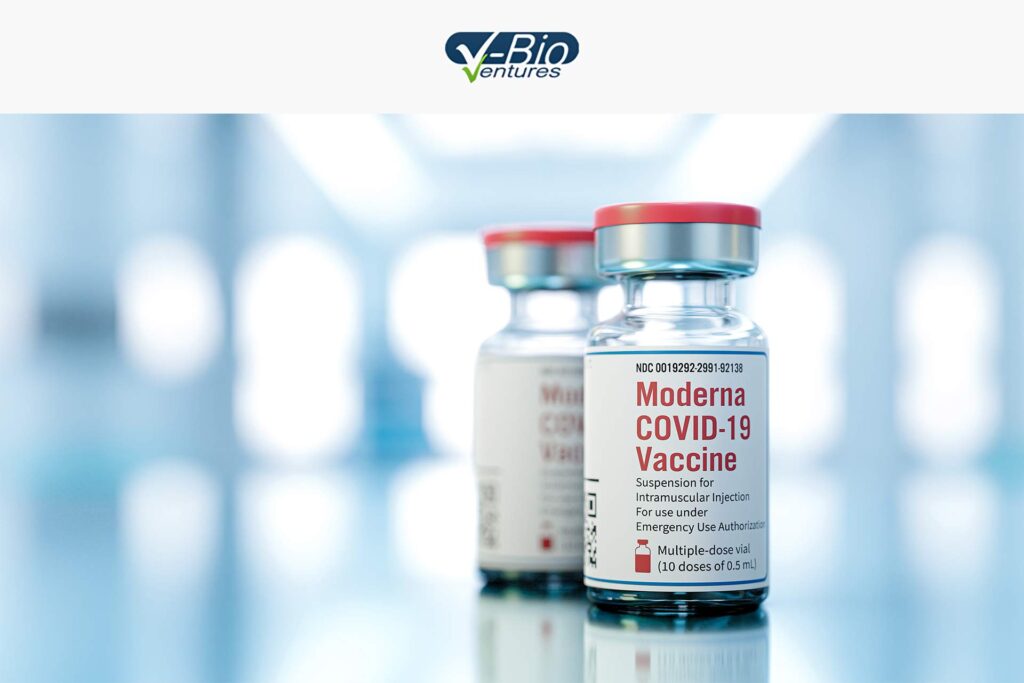

Moderna Therapeutics has never really been a typical biotech. Sure, nowadays it is world famous thanks to its COVID-19 vaccine, which has resulted in an $80 billion market cap and projected sales of $18.4 billion for 2021. But the path to success has not been that of a standard biotech’s journey. Through ups and downs, controversies and triumphs, here’s the fascinating story behind the rise of Moderna and the creation of its COVID-19 vaccine.
Founded in 2010, the goal of ModeRNA Therapeutics (as it was known back then) was to create a therapeutic modality based on mRNA. mRNA is chemically simple: similar to DNA, it’s composed of just 4 building blocks (A, G, C, and U instead of DNA’s T), but unlike the double-helix structure of DNA, mRNA is typically single stranded. It is the middleman in the code of life, translating DNA into a format that can be read by ribosomes which in turn produce proteins. Moderna’s hope was that a new modality based on mRNA would allow for easy manufacturing and could act as a substitute for protein replacement therapies, at a fraction of the cost, in thousands of applicable diseases.
The dream was bold. To understand how revolutionary the idea was not even a decade ago, you can watch this 2013 TEDx talk by CEO Stéphane Bancel, where he explains the company’s concept. The mRNA hype generated by Bancel allowed him to rake in billions of dollars in deals and financing rounds in the ensuing years, driving the valuation of Moderna into unicorn territory. While this was happening, the company embraced controversial stealth mode tactics, not publishing any data, and shrouding its technology in mystery.
Through dark times
In the following years, the grand dream was indeed on the verge of turning into a nightmare. The main disadvantage of mRNA drugs is that the body recognizes them as foreign: similar to an invading virus, they trigger a strong immune response. mRNA is also notoriously unstable and short-lived, only lasting a brief amount of time in the body before being broken down. To insert sufficient mRNA into cells that the protein production would have a measurable impact on a patient, these two major hurdles first had to be overcome.
Moderna’s hope was that a new modality based on mRNA would allow for easy manufacturing and could act as a substitute for protein replacement therapies, at a fraction of the cost, in thousands of applicable diseases.
A discovery by Katalin Karikó and Drew Weissman in the 2000s was to provide a solution to the immunogenicity issue. The breakthrough, which was also licensed to BioNTech, lay in modifying the mRNA to make it less visible to the innate immune system by changing uridine (the ‘U’) to pseudouridine. Large portions of Moderna’s war chest were spent on improving this method and solving the mRNA administration issues, initially with limited success. Leaks from within the company sparked concern over how much money was seemingly going down the drain. By 2016, despite having raised hundreds of millions of dollars and running over 100 active programs, the company had yet to progress more than a single compound into the clinic.
Rumors abounded, exacerbated by high-profile departures and reports of a demanding competitive corporate culture more reminiscent of Silicon Valley than of Boston biotech. The company’s secrecy raised suspicions, drawing unfavorable comparisons to Theranos: the high-profile, furtive life sciences unicorn whose implosion rocked the biotech world. Confidence in Moderna’s dream was rapidly dwindling
Into the light
Despite the darkness, a light at the end of the tunnel was rapidly approaching. What do you do if your technology is highly immunogenic and hard to systemically administer? You look for locally administered applications that benefit from immune activation! Given the company’s struggles, Bancel decided to pivot. Vaccines were perhaps not as sexy as the treatments that had been touted, but they could serve as a buffer against failure while the company further improved its mRNA technology.
Much to the chagrin of some employees, who found the strategic changes less than transformational, the focus was shifted to vaccines. Data started emerging in small pilot trials demonstrating that vaccines based on mRNA packaged in lipid nanoparticles could indeed be useful. However, they would have to compete with existing vaccine platforms that were already considered safe and established. This did not stifle confidence in the new approach though: Moderna grew in size and valuation, and went public in late 2018.
Bancel was among the first to learn of a potentially dangerous new virus emerging in Wuhan. He quickly realized it could serve as the perfect showcase for Moderna’s vaccine platform.
Despite the large pipeline, the company’s lack of significant progress kept a lid on the stock price until early 2020. Then, the world changed. Partly thanks to his relationship with the National Institute for Allergies and Infectious Disease (NIAID) and its famous director Anthony Fauci, Bancel was among the first to learn of a potentially dangerous new virus emerging in Wuhan. He quickly realized it could serve as the perfect showcase for Moderna’s vaccine platform.
A star is born
The SARS-CoV-2 genome sequence was released on January 11th 2020. As companies with classic vaccine technologies got to work producing proteins or viruses expressing antigens, mRNA companies BioNTech and Moderna raced ahead. One of the advantages of mRNA technology is how quick the code is to create and adapt: following the publication of the SARS-CoV-2 genome sequence, the Moderna team were able to design the mRNA sequence for its vaccine in merely two days.
The record-breaking speed at which Moderna was able to develop its COVID-19 vaccine is now widely known: the first human trial was launched in May 2020 and, thanks in part to funding from Operation Warp Speed, the company published the successful interim results of its first Phase III trial less than six months later, paving the way for approval by regulatory bodies around the world. On December 18th, 2020, the Moderna COVID-19 vaccine was the second to be approved by the FDA, a mere seven days after it had approved the mRNA vaccine by BioNTech-Pfizer.
By the time of this publication, many millions of people will have been inoculated with Moderna’s vaccine. The company boasts of a supply forecast of up to 1 billion doses produced by end of 2021, no doubt saving many lives and helping the world get back to normal after the worst pandemic in a century.
Despite the hardships, this year will also be remembered as a triumph of science and human ingenuity. For Moderna, that success was made possible thanks to an audacious CEO who kept selling the dream against all odds, patiently outwaiting the sceptics until he could pounce on the perfect application. It shows that platform technologies, no matter how promising, can take a long time to find their sweet spot. Luck, persistence, and silly amounts of funding may be required, but the investment can be well worth the wait.
